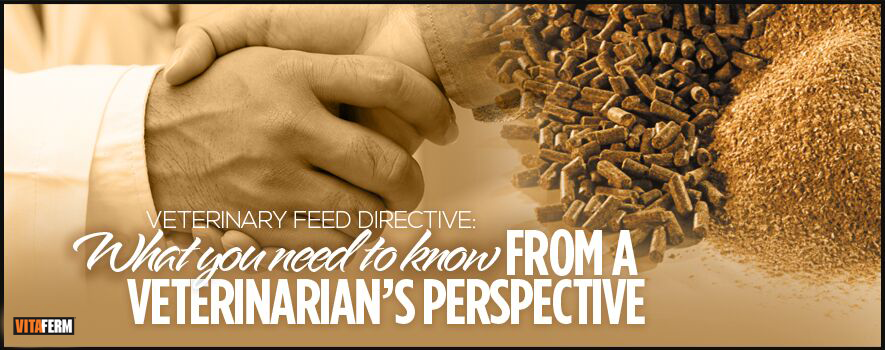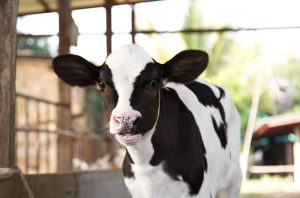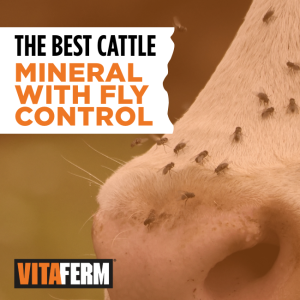by Dr. Donald Sunday, DMV
One of the most important pieces of legislation that will affect cattle producers, veterinarians, and the animal health industry is set to go into effect January 1, 2017. GFI 213 places the use of medically important antibiotics in feed or water under the supervision of licensed veterinarians. The Veterinary Feed Directive (VFD) has led to many questions, concerns, and at times uproar among those who will be impacted. Anytime federal regulation touches us and we become concerned about our costs of production rising, it is understandable that one’s voice and blood pressure may rise as well. I hope to qualm some fears and answer some questions you may have in this article as well as offer insight into management practices which may decrease the need for antibiotic use.
We must first define what drugs are affected by the rule. Only antibiotics listed as medically important by the FDA and administered in the feed or water fall under the provisions of GFI 213. From a health standpoint, most of us are concerned with its impact on tetracycline (CTC) derivatives and tylosin. Non-prescription antibiotics, such as penicillin and oxytetracycline will still be able to be purchased over the counter at places like a coop or feed store. Though there may be legislation in the future that makes them unavailable without a prescription, their status will remain unchanged at this time. There are also no changes to prescription antibiotics at this time. If you read a label today that states “Federal law restricts the use of this drug by or on the order of a licensed veterinarian,” that means it is and always has been a prescription drug. Those were always legally required to be used under a valid Veterinary-Client-Patient relationship (VCPR).
A VCPR is defined as the veterinarian having examined the animals in a medically appropriate time relative to treatment, he or she has agreed with the producer to assume responsibility for medical decisions, and is available for follow up consultation or re-examination if needed. An excellent time for the cow-calf producer to fulfill the requirements would be during preg check or when processing calves with the veterinarian. These are great times to review case definitions of disease, examine the herd, and have a consult on the proper use of antibiotics. Many feedlots and stocker operations have a veterinarian who makes regular visits and will be responsible for proper use of VFD drugs. If you are not currently using a veterinarian in your operation, it is highly suggested to develop a relationship now to make the transition into the VFD era as smooth as possible.
You will no longer see a growth promotion label on medically important feed grade antibiotics as well. This will help to curb the public misconception that we overuse antibiotics only for increase in weight gain. Ionophores and coccidiostats, like lasolocid and monensin, are not affected by this rule, so long as they are fed in a legal combination. For example monensin is not approved to be fed concurrently with chlortetracycline, but it is with tilmicosin. Likewise, you may not legally combine lasolacid with tilmicosin, but you may feed lasolocid and chlortetracycline. It is also pertinent to note that insect growth regulators (IGR) used in fly control mineral are not VFD drugs.
So, after the ball drops on New Year’s Eve, if a VFD drug is to be used, you must consult with your veterinarian and he or she will have to fill out a Veterinary Feed Directive form. It will include you and your veterinarian’s name, address, and phone number, as well as the location of the animals. There may be only one drug and label use on each VFD form. This means that it cannot be stated you are treating both anaplasmosis and pneumonia. They must be listed on separate forms. Also to be included is the approximate number of head treated and how much drug will be added, usually listed in grams per ton. There also will be a statement that extra-label use is not permitted. This means that you cannot deviate from the amount, duration, or use of the drug. A VFD may be authorized for a single treatment or for use up to six months. At the end of six months, another VFD must be authorized.
Although chlortetracycline (CTC) in the feed and mineral has been used to treat footrot and pinkeye, this is extra label use of the drug. This means that CTC is not labeled for such a treatment and never has been. We never legally were allowed to use drugs in the feed extra label, even though it has been common practice. It is important to realize your veterinarian cannot authorize a VFD for CTC to treat footrot or pinkeye.
Another concern has been how exact the measurements will be of the drug listed on a VFD. Please know that there are biological variances in feed and mineral intake from animal to animal, and therefore you will not see a specific allotment of drug on the VFD. For example, if a medicated mineral is labeled for free choice feeding, it is understandable there are decreases and increases in intake and so, only the approximate number of animals being fed are required on the VFD.
One aspect we must all be cognizant of is the rising amount of antimicrobial use and pathogen resistance to the drugs in the beef industry. According to Derrel Peel of Oklahoma State, from 2009 to 2014, antibiotic sales increased from $520 million to $742 million-a 43% increase. Unfortunately, in the feedlot industry, mortality has increased 0.5% each year in the same time period. So, we are using substantially more antibiotics, with a less than desirable result. Our treatment costs are going up, and so is our death loss.
Last year, there were 20.8 million pounds of medically important antibiotics sold in the animal health industry, and tetracycline made up 70% of those sales. The drug Aureomycin, which many of us are familiar with, is chlortetracycline. With concern over the total amount of antibiotics used rising and the issue of antibiotic resistance increasing, the legislation was passed to ensure we are using antibiotics in a medically appropriate manner.
The most deadly bacteria causing respiratory disease in cattle is Mannheimia haemolytica, previously known as Pasteurella haemolytica. Considering data provided by Dr. Brian Luebbers of Kansas State, nearly 80% of Mannheimia haemolytica isolates sent to the diagnostic lab last year from lungs of animals are resistant to oxytetracycline. Oxytetracycline is a commonly used injectable product, and very similar to tetracyclines used in the feed like Aureomycin. From 2007 to 2014, resistance to the injectable antibiotics enrofloxacin and tulathromycin have increased from less than 10% and 30%, respectively, to over 70%. That must make us question where we may be in another seven years. We certainly do not want to be left without any treatment options.
There are many aspects to consider in the health of cattle. Genetics, weather, stress, nutrition, animal handling, environment, and immune system function all play a role. It is ill advised to believe that the health of your herd will be at risk if you are asked to make a change in how and when you add antibiotics to their feed or mineral when there are so many influential factors. Nutrition cannot be over looked. If your cattle have a vitamin A deficiency, calves are more likely to suffer from scours as neonates and pinkeye when on pasture. Animals lacking selenium and copper are more likely to develop respiratory disease. Consultation with your veterinarian or a nutritionist can ensure you are providing the proper feedstuffs and vitamin/mineral supplementation to your herd.
Through conversations with your veterinarian, there may be strategies and practices you can develop to decrease your use of antibiotics and increase your revenue while keeping animals healthy. If you are not utilizing a proper vaccine program, you may be treating viral infections, such as Bovine Viral Diarrhea (BVD) or Infectious Bovine Rhinotracheitis (IBR), with antibiotics. An antibiotic will have no effect on a virus and a consult with your veterinarian can allow for proper testing, vaccination, and an increase in animal health – which will add pounds to your calves and dollars to your checkbook.
Anything we can do to lower stress levels on our cattle will help their health status. Practices such as fenceline weaning substantially reduce the stress on weaned calves as well as their mothers. The more a calf is stressed, the more likely he is to get sick, and the more his performance suffers. It is imperative to castrate and dehorn as young as possible. The testes do not produce testosterone, which will increase growth, until the calf is 7 to 12 months old. So by leaving bulls intact, we are not gaining anything. In fact bull calves or yearlings entering the feedlot can be 3 times more likely to be treated for bovine respiratory disease than their steer mates.
Though there is extensive use of chlortetracycline (CTC) in the feed for prevention of pneumonia, CTC is not labeled in such a manner. It is only labeled to treat or control, not prevent. While there may be data showing the benefit both from an animal health and financial standpoint, this practice is no longer acceptable unless done under the supervision of your veterinarian. It is important to note that this is most commonly done in long haul, high risk cattle. There are cattle shipped all over the country to central feeding locations and many are sourced from small herds and mixed together. That is not likely to change but what we can control is the management prior to entering the feedlot. We must remember the old adage that cattle that don’t eat get sick, and cattle that are sick don’t eat. So, as a treatment drug, feed grade antibiotics may not be an exceptional option if cattle are not ingesting them.
As the Veterinary Feed Directive approaches, always consider the risks and costs as well as the benefits of using an antibiotic. Farmers and ranchers in the United States produce the safest and highest quality product in the world and this legislation does not change that fact. Antibiotics will always have a place in our production system so long as they are used appropriately. It will be vital that we continue to use them judiciously and to seek animal health and husbandry practices that boost our care for our animals.
Dr. Donald Sunday and his wife Amy, who is also a veterinarian, own and operate Heartland Veterinary Health Center in Holton, KS. Their practice is focused on stocker, cow-calf, and feedlot medicine, as well as embryo transfer and companion animal care. Dr. Don enjoys the atmosphere of a small town, rural environment and providing excellent care to his patients.
He is a native of Dallastown, PA and pursued further education at Black Hawk East where he was a member of the livestock judging team. He received his Bachelor’s degree in animal science at Kansas State University where he also judged. He met his wife in vet school and they both graduated from KSU in 2012.



